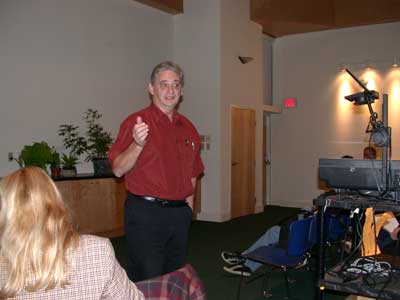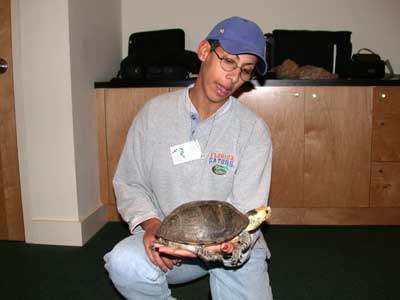| JAN |
| 2003 |

Dr. Richard Blaney - The Subspecies Concept
Lynn Monlezun called the meeting to order and asked Manny Granados to present an issue which had been brought before the Executive Committee. Manny explained to the group that a local ordnance was recently being enforced which required all turtles (tortoises included) that were being offered for sale, trade, barter or gift to be accompanied with documentation proving them to be disease (salmonella) free and that said documentation was to be provided by the head medical representative of the state of origin of the turtle shipment/group. The enforcement of this ordnance has potentially drastic effects on the herp community at large and is being closely monitored by several members of the society. Interested people may contact Manny Granados at sales@myexotix.com or Vic Morgan at victortois@aol.com.
Mike Monlezun next introduced this month’s guest speaker as Dr. Richard Blaney, a professor and head of the science department at Brevard Community College, whose topic was "The subspecies concept". As an introduction to properly done subspeciation, Dr. Blaney introduced several slides covering the breakdown of Terrapene (American Box Turtles) into specific species in which some hybridization occurs resulting, in some cases, in sterile "mules" and, in others, animals capable of backcrossing into their individual communities. He then produced a specimen of Terrapene carolina major (Gulf Coast Box Turtle) which he had collected as an old adult specimen on St. Vincent Island in 1966. "Dummy", as this ancient turtle is affectionately named, was alert and active and even posed for pictures after the meeting.
To emphasize that appearance is not always a good indicator of species identification, Dr. Blaney produced a slide of a snake collected in Quintana Roo (by him) that was almost entirely red with some black markings. The snake, when studied, turned out to be a Micrurus diastema (Central American Coral Snake) which normally follows the red touch yellow pattern common in North American Coral Snakes. He went on to explain that Lampropeltis getula brooksi and L. g. floridana were actually the same animal but some individuals were more prominently banded than others. He explained that the conventional "floridana" was actually a hybridization between L. g. brooksi and L. g. getula. He further explained some other hybridizations which had originally been described as individual subspecies such as L. g. yumanensis which was actually an intergrade between L. g. nigritus and L. g. californae. In describing how species and subspecies are determined, Dr. Blaney strongly supported the need for multiple points of separation as opposed to the recent uprise in popularity of single point DNA comparisons and the discarding of nonsupportive data. One such method of comparison that he displayed in his slide presentation was the hemipenal structural differences between various kingsnake subspecies. Based on that and other differences he explained that a major restructuring of kingsnake subspeciation was imminent.
Dr. Blaney’s current work is in studying the change of traditional range areas of the various ratsnake populations on the east coast and how that has affected the areas of intergradation. Accounts support the absorption of the Everglades Rat Snake by the Yellow Rat Snake population due to the introduction of the Australian Pine as well as the other major habitat changes made to the Everglades. Another major change in range areas is occurring in northern Florida with the expansion eastward of Grey Rat populations into traditionally Yellow Rat Snake areas resulting in some very striking intergrades. The expansion appears to be following the corridors through habitat caused by the routing of interstate highways and their associated higher, drier ground and shoulder areas which is more suitable habitat for Grey Rat Snakes than Yellow Rat Snakes. One of the most interesting discoveries that Dr. Blaney disclosed was that hybrids between the "blotched" E. obsoleta group and the "striped" E. obsoleta groups result in a specific sexual dimorphism. Specifically, male hybrids are blotched and female hybrids are striped. Therefore, based on this data point, a striped male Yellow Rat Snake would NOT be a hybrid. For his continuing study, Dr. Blaney is interested in any individual specimen locality information which you might be able to provide concerning rat snakes in the northern portion of Florida and the southern and central portions of Georgia, including photographs if available.
|
The presentation was followed with an informal photo shoot starring "Dummy" the Gulf Coast Box Turtle. Our thanks to Dr. Blaney and his wife for an outstanding presentation. |
|||||
|
|||||

